Chris James's Blog
November 9, 2025
The pond
This post details at length how I have built a pond over the last three months. This came about because writing ground-breaking science fiction novels wasn’t difficult enough, so the vast glob of natural idiocy buried deep in my subconscious decided I should take on a project even more challenging. Therefore, do please grab a mug/cup/glass of your preferred beverage, pull up a chair, and read all about the laughter and the tears; the triumphs and the disasters; the victories and the defeats; and the moments of doubt and of revelation, as this hole in the ground in July…
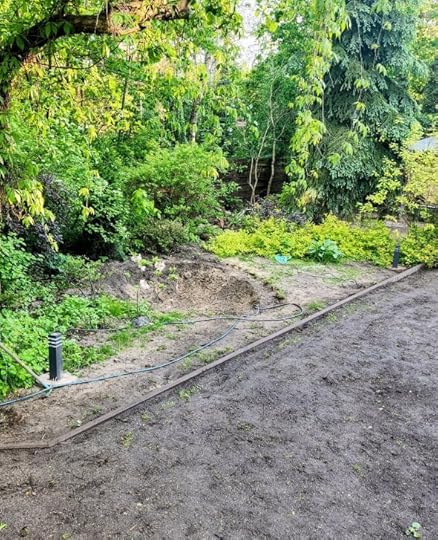
…became this pond today:

The decision
In the spring, we had some workmen in to make improvements in the back garden. They laid some edging stones to separate the grass from the flower beds, and then sowed a new lawn. Mrs James got them to dig a small hole off to one side, “in case we decide to have a pond”. In late July, I had the house to myself for a few days and stared at the hole, now with weeds spreading and the remains of a red squirrel one of the cats had killed lying forlornly in the dirt.
It could not remain like that.
I asked myself: do I fill the hole in and plant some shrubs, or do I build a pond? I knew the answer at once, and a voice in my head urged: if you’re going to build a pond, make it big enough and build it only once. So, without proper planning—thus making myself a hostage to future unavoidable costs—I dug a pond that would be appropriate to the size of the garden. At that point, I thought that finishing the project by the end of September would be a breeze. Happy times.

The hole
If you decide to build a pond, take some advice: cost the entire project before you dig the first sod. I didn’t, and it would prove to be a pricey mistake.

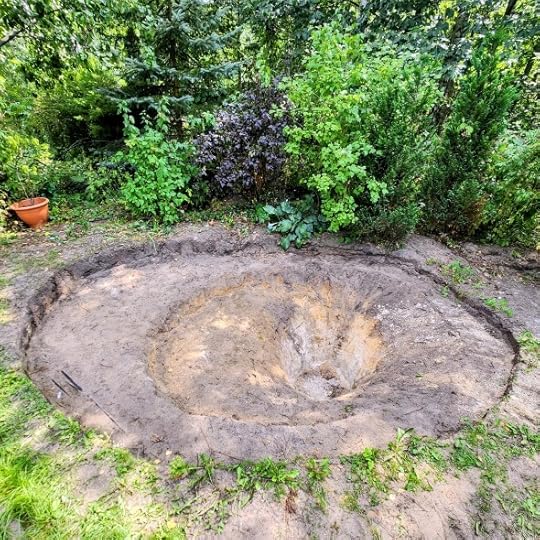
With the digging done, research showed that the safest way to proceed was to wire and concrete the hole. This would prevent roots from surrounding shrubs and trees piercing the liner. As luck would have it, I had a load of chicken wire stashed away from a couple of years ago when we let the hens roam in most of the garden.


Once the kids and I had concreted the hole (I got them on the cement mixer and loading me out while I stood in the bowl-shaped bottom :)), I realised I needed to concrete a level surface ledge. At the beginning, Mrs James and I had used a water level to get an approximation of how the ground lay, but now I fell back on my trusty two-metre straight-edge and small spirit level to methodically move around the top lip. I also thought it was high time to leave some evidence for future generations not only that I had been here, but also when:
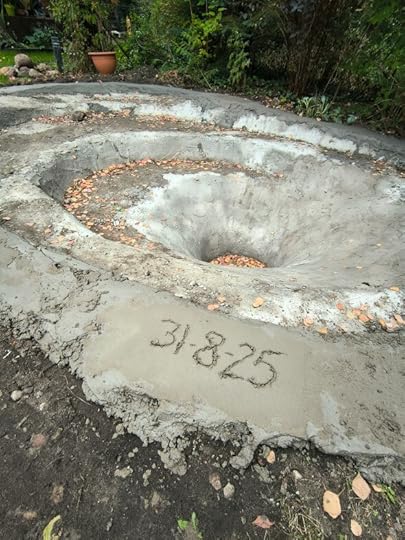
Then it was time to get the liner. There are many types, but the generally accepted best is called EPDM. Imagine the rubber that bicycle innertubes are made from, only a heavy 1.25mm thick. It’s slippery. It weighs a ton. It’s expensive. And I needed 80 square metres of the stuff. To make matters worse, I miscalculated slightly, and bought more than I needed. It cost an eye-watering EUR 1,300 (I will give all figures in EUR). Eldest Daughter and Mrs James helped to get it in place:
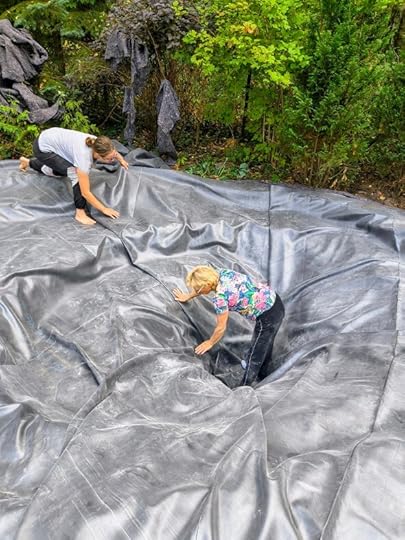
However, my miscalculation has left me with a strip of EPDM 2.8m wide by 8.8m long. So if you know anyone who’s building a small canal in their garden, tell them there’s some spare liner going cheap at my place. Thanks.
The Mauser
A pond is essentially a “water circuit”. A pump sits in it and sends the water to a filter. The filter removes impurities and then clean water returns to the pond, often via a feature like a waterfall. Sounds simple, doesn’t it? Research offered up several options for the filter, but I decided to copy my next door neighbour and get one of these:

The advantage here is that a biofilter of this size needs almost no maintenance. If you get a small filter of the kind pond-specialist companies will sell you, you’ll have to clean the media inside it once a week (more often in summer). But by constructing a biofilter inside this beast, my pond should be maintenance-free for years. The media is made up of small, expanded clay balls called LECA, on which “good bacteria” grow as they consume nitrogen and other impurities from the pond water as it passes through. This is an important consideration if, for example, you plan to continue taking summer vacations and don’t want to come back to a dirty pond full of dead fish. On the other hand, the inflow and outflow arrangement inside the Mauser required many hours of patient work:
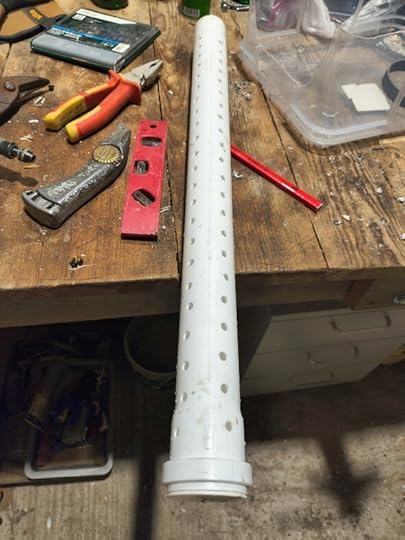
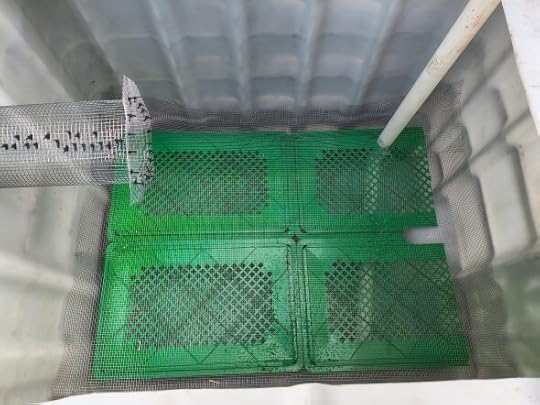
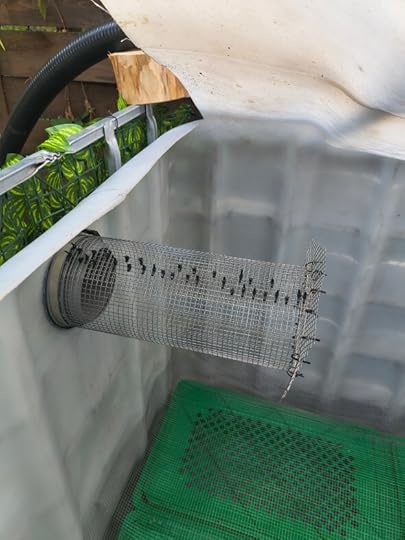
In the above image, covering the outflow pipe is galvanised wire mesh with 6mm holes. The balls of LECA are from 8mm to 20mm in size, and obviously must not be able to get into the pond.
The waterfall
As with the pond itself, the waterfall had to be commensurate with its surroundings, and here I had a problem: all of the videos I’d watched on YouTube showed burly guys chucking rocks about that must’ve weighed tons, and sometimes using a mini-digger. All I had were the stones we’d collected from fields, riverbeds and mountains over 20+ years of vacations. Given the spiralling costs, I could not justify expenditure on that scale, and in any case, I wanted to do the work myself. Fortunately, we had rubble left over from various other projects so, layer by layer, I poured concrete on rubble interspersed with more wire, until I had the outline of a feature and a height that would suit the outlet flow from the Mauser.



The problems only really began when I put everything together. Firstly, my key focus had been on the filter: when the thing was full of 250 litres of LECA, there would be no going back—the internal plumbing simply had to work. The waterfall became the artsy-fartsy part of the project. I knocked up wheelbarrow-fulls of sand and cement, and set slate and stones at my whim, not realising I was building in one particular headache.
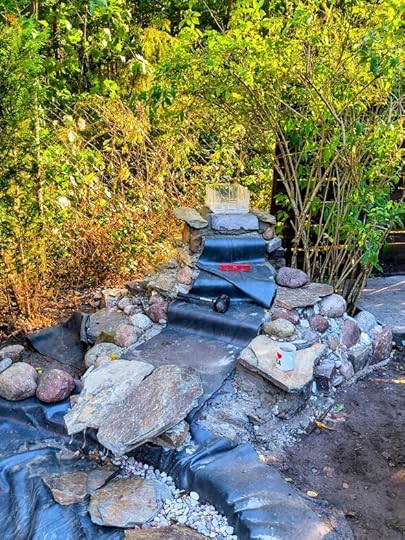
At last, I connected everything up. The Aquael ECO 15,000 pump (EUR 200) sat on the lower ledge with a 50mm flexi-pipe running along the back fence, behind the waterfall, and up to the top of the Mauser. After passing the ball-valve, the “circuit” then turned 90 degrees down to the bottom of the Mauser, exiting through that perforated pipe you saw earlier. The water then rose through the LECA to leave the Mauser via the 110mm outflow pipe, whose other end rested on the lip of the header box at the top of the waterfall. But the waterfall leaked. A lot. And I would need two attempts to fix it. There’s no need to dwell on my head-slapping lapse of concentration, but you can see in the picture above that the joint between the clear plastic header box and the stones was bound to haemorrhage water. Isn’t hindsight a wonderful thing?
The brick hide
Last year, we had some electricians in to wire lights around the garden. They also left a length of exposed cable out of the ground, “in case we decided to have a pond”. However, the cable was now in the wrong place. Ideally, you want to keep your electrics out of sight, hidden somewhere around the edge of the pond where no one goes. But this was now impossible, so I decided I had to make a feature and build a devoted hide that would house a few power points for the pump, heater and anything else I needed to plug in. I went to a renown Warsaw brick manufacturer and blew a cool EUR 250 on just 60 bricks and three coping stones. Once again, I bought too many so made another small feature on the opposite side to try and give a little bit of symmetry.

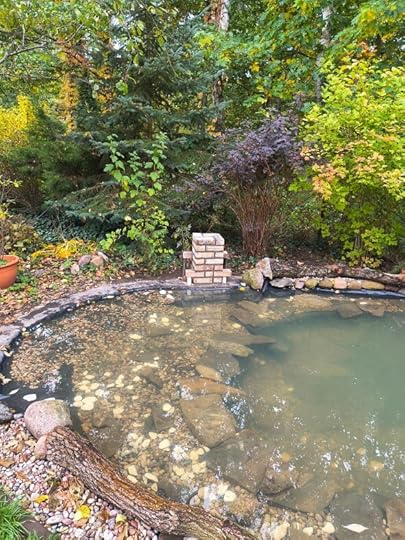
The insulation
Then, a new issue came up: winter. This year would not be a problem because the pond will not have any fish, but future years would need a solution. This led to me removing the camouflage and cladding the Mauser in 30mm polystyrene, the external type that weighs nothing but which is as hard as nails. And yes, pond heaters are available at a price. A high price. For which I have a year to save up.
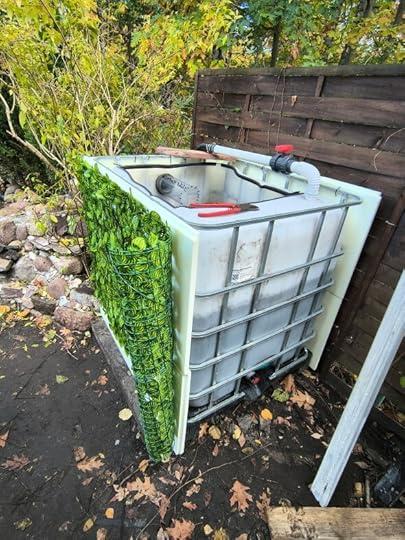


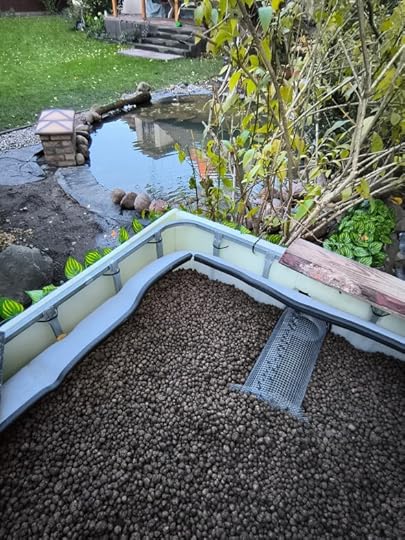
The lid of the Mauser
Something else began bugging me: to fit the plumbing and put the LECA inside the Mauser, I’d been obliged to cut a large section out of the top. I naïvely thought it would just sit right back on. But no:

Even edged with metal reinforced EPDM lining, it would not just snuggle back into its hole.

So, I grabbed some lengths of shuttering wood I still had from when a neighbour gave a load away a few years ago, and cut, sanded, and primed them. Two coats of decent all-weather paint and I had a proper lid. Then, we had a storm. Twigs and branches from a dead silver birch next door came raining down and it suddenly became clear that the inflow pipe with the ball-valve was at risk of damage and also needed protecting. Fortunately, I had some batons I saved when I took an old bed to pieces last year, and was able to use those to make this:
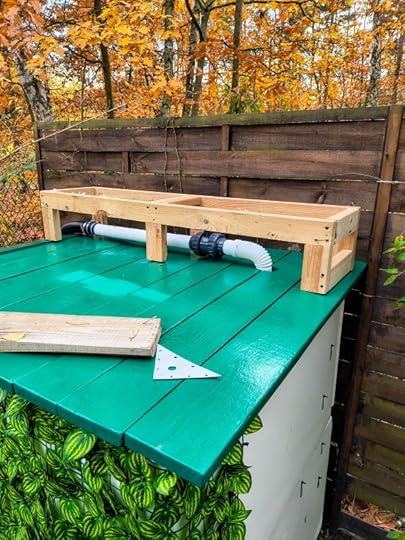
So, now, the Mauser looks like this, properly insulated and protected against most of the elements:
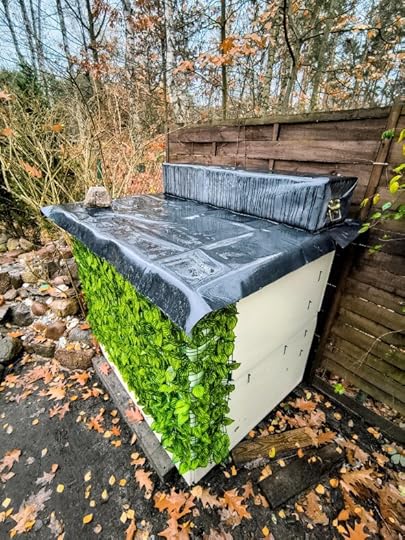
The project then moved to the finishing-touches phase, washing and loading out the stones and pebbles while fighting every day to keep the pond free of leaves, until today. Of course, the best is yet to come. When spring rolls around next year, I plan to introduce the first fish and plants.

Overall, I’ll put this project down as one where I almost bit off more than I could chew—but not quite. The entire total cost I estimate at around EUR 2,500-2,750. For every unexpected or underestimated amount, there were wins, including EUR 100 for the second-hand Mauser and buying two tons of small stones and pea shingle more cheaply from a builder’s merchant, which meant I had to drill holes in an old wheelbarrow to wash the mud and clay off them before I could put them in and around the pond. In addition, I had stuff lying around I was able to use to avoid having to buy materials. Other costs included EUR 100 for the pieces of slate, EUR 100 for the LECA, EUR 50 for the inflow pipe from the pump to the Mauser, and EUR 30 for the ball-value.
However, the biggest saving was the labour. Pond building is an expensive business. I considered and discarded a few design options because the prices of the specialist equipment were ridiculously extortionate (EUR 300 just for a glorified plastic waste-paper bin?), and I shudder to think how much a firm of professionals would charge to construct the pond I’ve just built. In addition, the Mauser biofilter is a pretty bespoke solution to keeping your pond maintenance-free, and I’m not sure professional pond-builders would be prepared to offer it. From their perspective, giving you the smallest filter would make their job easier, and they hardly care if you’re stuck cleaning your filter out every week once they’ve built your pond and got your money.
If I had researched the project before I began, I would’ve undoubtedly built a smaller pond. But, on the other hand, by proceeding in wilful ignorance in July, I have ended up, more or less, with the pond I decided to aim for.
In any case, the one thing I am proud of is that, after weeks of waiting, working and sweating, it transpired that I got the entire circumference of the pond to within just 1cm of level. And for that, I can forgive my pure idiocy when building the waterfall.
You can bet that next year, I’ll post more pictures of this pond as it grows in. Thanks for reading and take care, peeps!
September 28, 2025
Anthropic update, keto for the win, and other projects
I’ve fallen into repeating a mantra that must have become a cliché by now: that weeks seem to pass like days, months like weeks, seasons like months, and years like seasons. I wonder where the time has gone, until a voice in my head lists everything that’s been happening. And things have been busy.
First, the most important news is that the judge in the Anthropic class action has approved the settlement (yay!). If your books were stolen by Library Genesis, then you will need to check if you are eligible for compensation. As I mentioned in March this year, visit the Authors Guild to keep updated. The list of stolen books is due to be published on Tuesday, and hopefully this case will presage more of those greedy tech-bros being obliged to pay creators for what they stole to train their AIs.
Elsewhere, since my fast in June, I’ve been on a keto diet. An acquaintance convinced me to try it when he lost a lot of weight. Three months later, and I can also highly recommend it as a way to shed a spare tyre, keep functioning, and still eat enough. For me, quitting all sugar (processed and natural) and all the starchy foods like potatoes, pasta and rice, came incredibly easily; so easily, in fact, that I find my lack of reaction itself to be a curiosity. Having had a sweet tooth my whole life, I expected that going without sugar would be a serious challenge. But nope. The good thing about keto is you can eat as much as of the permitted foods as you like and still lose weight. And it’s true: I stuff my face with platefuls of meat, fish, veg and salad and the pounds keep falling off. And to be sure I get enough vitamins, etc., I eat eggs and some fish every day. The best part is that my gammy knee, now obliged to carry 18 fewer kilos than three months ago, has stopped hurting. Phew! If you want/need to lose weight, give the keto diet a try.
Finally for this post, once I finished redecorating the office in July, I started a new project in the back garden: building a pond. I’ve never built a pond before. And now I can say with a fair degree certainty that I shan’t ever build one again. After more than two months, the thing is finally nearing completion, and I plan a long, image-packed post when it’s done. But for now, I’ll leave you with a few pictures of some of the things that building a pond involves… in addition to a quite outrageous amount of hard graft.
Thanks for reading and stay safe, peeps!
This is the inflow pipe that will sit at the bottom of the biofilter. The maths says it needs precisely 46 evenly spaced 7mm holes. So that’s what it’s jolly well got.

This is called a ball valve. It’s supposed to put you in control of the flow, oh yes!

This is called a Mauser. It’s a one-cubic-metre plastic tub that comes in a metal frame.

The Mauser will hold the media that constitutes the biofilter. It should be kept out of sight of the pond, ho, ho, ho.

Finally, here is a detail of the waterfall. Like everything about this project, it’s bigger and more time consuming than I’d anticipated… but still looks quite nice 

July 13, 2025
Rawl plug rant
I never expected that an everyday item such as a plastic rawl plug would leave me shaking my head in complete dumbfoundedness, but I am going to use my little space here on the internet to ask you to compare these two rawl plugs. The white one on the left came with a set of blinds that I fitted yesterday, after redecorating my office, which I purchased from Castorama three days ago. I bought the red one on the right from a hardware store in Staines, the UK, sometime around 1995.

There is little to tell between the two. They both have a 6mm diameter and a similar design, with winglets that should push outwards and brace the rawl plug against the wall as the screw goes in. The wall into which I drilled the holes for them is made of common, clay bricks that I plastered, 24 years ago, in around 6-8mm of chalk-based plaster. I inserted the white rawl plug, offered up the bracket and screw, and began screwing. But before the screw tightened, the rawl plug slipped and then spun against the side of the hole (the screws also came with the blinds, so they were the right ones).
 The office being redecorated
The office being redecoratedAfter much grumpy-old-man swearing that fings ain’t wot they used to be, I decided to put my moaning to the test and fetched my old, 30-year-plus red rawl plugs that I’d actually brought with me on emigrating to Poland in 1998. And yes, in the hole vacated by the white rawl plug, the red slid in, and when I turned the screw, the red rawl plug bit with reassuring firmness and easily secured the brackets for these blinds:

Each blind needed four screws. For the first few, I repeated the test, becoming evermore astonished that the reds would bite strongly in the same holes in which the whites slipped and spun. Then I just used the reds to get the remaining blinds up.
If anything like this happens to you but you do not have access to proper rawl plugs from the 1990s, you can always do it the old-fashioned way: chop up slivers of wood, pack them into the drilled hole (but not too tightly), and then turn your screw into the wood instead.
I tell you, peeps, today’s rawl plugs are bloody hopeless, although I haven’t the foggiest idea why. Answers on a postcard, please. In the meantime, I hope my dwindling supply of those fabulous red rawl plugs will last me a little while yet 

June 29, 2025
Book, documentary and film reviews
Well, those three months since my last post positively shot by, didn’t they? I naïvely thought that if I took a year off writing and didn’t publish a novel, I’d have more time to blog. Nope, real life got in the way. However, I have just returned from a ten-day fasting retreat during which I finally finished reading a delightful fantasy book I’d started earlier in the year, and spent some indulgent downtime on Netflix and YouTube.
Here are my reviews, interspersed with pics of the gorgeous Polish countryside where I was staying:
Tale of the Seasons’ Weaver by D. Wallace Peach

Five stars. This fantasy novel is a thoughtful, immersive journey into a richly imagined world. At its heart is Erith, a half-human protagonist whose inner conflict—torn between two natures—grounds the story in relatable emotional depth. Her struggle will certainly grip you, and it lent a subtle strength as the story unfolded.
What impressed me most was Peach’s prose style. Her writing is elegant and controlled—concise without being sparse, and often highly evocative. She wields a deft pen with light, elegant strokes. I found myself drawn into scenes that appealed to the senses, from the whisper of frost in the trees to the texture of moss beneath moonlight. Even as someone who doesn’t naturally gravitate towards the fantasy genre, I appreciated how vividly this world is brought to life.
The novel also boasts a remarkable range of supporting characters, each distinct and engaging, with characters’ feminine and masculine qualities being handled with real verve. Peach weaves all of them into the narrative with confidence, giving the sense of a world that extends far beyond the page. The mythic tone—drawing on a wide range of folklore and seasonal symbolism—adds a lyrical, almost timeless quality to the story.
Readers who enjoy immersive worldbuilding, internal conflict, and elegantly crafted language will find much to lose themselves in here. Tale of the Seasons’ Weaver offers more than just escapism—it’s a quiet meditation on identity, nature, and transformation, wrapped in a narrative that rewards patient reading.

Grenfell Uncovered (Netflix)
Five stars. No one does unpunished corporate manslaughter quite like the British. On a summer’s night in June 2017, a London tower block that had been covered in cheap but highly flammable cladding erupted in flames. Seventy-two people lost their lives. This documentary looks at the causes and how those responsible still evade accountability, and how the supine British establishment effectively allows certain classes of people not to have to face justice. Watch this nightmare scenario that came true and remember it the next time you hear a right-wing politician demand that “red tape” has to be cut, because it’s cutting safety to increase company profits that leads to disasters like Grenfell.

Titan, the OceanGate submersible disaster (Netflix)
Five stars. This is an unsettling but gripping account of the Titan disaster, a submersible that imploded on its way to visit Titanic in the North Atlantic on 22 June 2023. Its destruction claimed the lives of five people, including three fare-paying passengers. Most of the blame lands on the OceanGate owner, Stockton Rush, with, it seemed to me, some justification; not simply because he was one of the casualties. The path to the disaster is laid out simply but comprehensively, without the kind of sensationalism that would’ve been an easier route for the documentary makers to take.

Five stars. If like me you find a certain fascination with how the airline industry learns from the disasters that very rarely happen, then this channel is a must-watch. Fronted by a Swedish airline captain who has an erudite and very easy-on-the-ear delivery, each video looks at one event (disaster or near-miss). What I particularly enjoy is how he goes into sufficient depth regarding how planes and airlines function without getting too heavily into jargon. He explains clearly how and why things went wrong, and what the airline industry has done since to ensure the same thing can’t happen again.
Below is my favourite video of his that I’ve seen so far: Polish LOT flight 16, which in 2011 had to land on its belly at Warsaw airport. This video is typical of the presenter’s style and delivery, and is nice to watch because there is a happy ending (and you will hardly believe that an enthusiastic cabin cleaner might have unwittingly caused the landing gear’s refusal to deploy).

The Intern (2015)
Two stars. This is the kind of film that only gets made when the right people have the right contacts with the right money. The two stars I’ve given it are for the leads, De Niro and Hathaway, because their acting carries the entire film. In terms of plot, there isn’t one. De Niro plays a retiree who joins a scheme to get some wrinklies back into a job. He becomes an intern for Hathaway’s start-up clothing company, which is expanding faster than she can cope. And that’s it. There are some well-drawn minor characters, a highly doubtful race against the clock with little-to-no stakes, and at the end, after a heavy dollop of saccharine, the characters are in exactly the same place they were at the start of the film. If you’re looking for the epitome of well-acted, plot-less irrelevance, this is the film for you.
Stay safe, peeps!

March 30, 2025
Library Genesis and all that jazz
This post is mainly for my fellow bookwrights and to try to help spread the news about Library Genesis, a Russian “theft-site” where 7.5 million stolen e-pub books are available because, you know, artists just love not getting paid for their work. I sometimes wonder if there’s anything the Russians haven’t stolen from the West over the last 500 years, but that’s the subject of another post.
What makes this theft different is that those feeble-minded simpletons at Meta (the holding company for FaceBook, Instagram, ad nauseum) decided they would use those stolen books to train their AI, because, presumably, they were feeble-minded enough to think they could get away with it. This week, I found out that at least five of those 7.5 million books are mine. It’s hardly the end of the world, of course, and publishing anything on the internet usually carries some risk of theft or other misuse (just ask the Orange Shit-Gibbon and the Poster Boy for the Age of Stupid, hehe).
The good news is that some of the affected authors have begun a class action in North Carolina suing Meta for breach of copyright. The better news is that, if your books are also on that list, then you are automatically included as a plaintiff in the class action. For all of the details and to find out if your books have been stolen and used without your permission, click through to this article on The Authors Guild (sans apostrophe, tsk). It contains all the information you need, including a link to the article in The Atlantic that offers a searchable database of stolen books, and offers a useful range of advice and tips to protect your books.
May God bless our pre-historic capitalist paradise and the Age of Stupid!

March 9, 2025
When domestic abuse goes global
Don’t read or listen to a word he says. He and his billionaire handlers know that words are meaningless, now. Today, Zelenskyy is a dictator; tomorrow, the President of Ukraine has started to see sense. Today, tariffs of such-and-such are imposed on so-and-so; tomorrow they are delayed (so his billionaire handlers can play the markets). Today, he declares war against Mars; tomorrow, it was only a joke. Today, he promises to drain the Pacific Ocean; tomorrow, it is a fine body of water.
This chaos has one objective: to create uncertainty and anxiety. Like a domestic abuser enjoying the mental as well as the physical pain he inflicts on his wife and children, he wants you to be scared, to worry what he will say or do next, to fear what mood he will be in at any given moment, and to fear if he will, at random, decide to hurt you or someone you care about.

Today’s regime in Washington is domestic abuse gone global. You can now only relax at the weekends, when the global abuser goes off to play golf and accept tribute from sycophants who must pay millions to gain his ear.
Do not read or listen to a word he says. Look at his actions. Since he and his deranged acolytes took over, they have sided with Russia at the UN, stopped the delivery of weapons to Ukraine, and stopped sharing intel with Ukraine. Already, Russia is able to murder – and is murdering – more Ukrainian civilians as a result of his treacherous betrayal. But this is about more than a former Soviet state.

Since the Soviet Union collapsed in 1989, Putin has repeatedly called it the greatest geopolitical disaster of the twentieth century. Putin’s objective since he took over Russia on 31 December 1999 has been the regaining of those countries lost and the restoration of the Soviet Union’s former empire. The one barrier standing in his way was the United States of America. Putin has always known that the primary strategic imperative to restoring his beloved Soviet Union was the defeat of the USA. However, this could never be achieved by conventional military means: the fiscal ramifications of the USSR’s collapse in 1989 gutted the Soviet armed forces. Even today, the Russian economy is little bigger than Italy’s. No, if Putin were to regain the countries that he believes rightfully belong to Russia, the USA had to be neutralised in a non-military way.
And this, after 25 long years, is what Putin has finally achieved. The United States of America stands today not as the leader of the free world, but neutralised. Side-lined. Castrated by a traitorous enemy within.
I grew up during the Cold War. I’ve followed Putin’s career for the last 25 years. His unprovoked invasions. His murders of critical journalists and political opponents. I saw Angela Merkel swoon and flutter her eyelashes when Putin gave her flowers and she made Germany dependent on Russian natural resources. All the time, Putin wore the face of a typical Russian tzar: that blank, fish-eyed expression of soulless callousness; just waiting, patiently, for those foolish Western career politicians to succumb to Russian bribery, coercion and honeytraps.
And now, Putin’s patience has been rewarded. Growing up in the 1980s, I never entertained for a minute the possibility that the Soviet Union could really defeat the West. But time is a thief, and the decades have sped by too quickly. Today, the United States of America has indeed been defeated. Not by a stronger army. Not by nuclear weapons. But by a third-rate KGB goon who murdered and bribed his way to control of the Kremlin and Russia. The West thought it had won the Cold War. We were wrong. Today, a gormless rapist, failed businessman and shallow coward open to bribery by anyone willing to pay the right price has cut the meniscuses of the most powerful country on Earth, and the world stares in disbelief as it stumbles to its knees, hostage to the killer in the Kremlin; outsmarted, outmanoeuvred, and defeated by the enemy within.
The Cold War didn’t end in 1989. That was just the first leg. And now, 36 years later, Russia has won the return fixture. When will the tiebreaker be?

February 23, 2025
Touristy tips for a city break in Rome
Before I get to the pictures, here are a few takeaways from a long weekend Mrs James and I had in Rome last weekend. Consider the following if you’re planning a trip to do touristy stuff in this remarkable city.
1. The early bird catches the relaxing cappuccino. Like most tourist hotspots, buy your tickets online and arrive at the venue before it opens. You can enjoy a coffee and keep ahead of the crowds for the first little while, at least.
2. At the Pantheon, invest in the audio guide, which was the best of all the places we visited and will really help you enjoy the building and its history (you need to give them some ID as a deposit for the handset the guide is on).
3. Consider what you want from St. Peter’s Basilica before you go. If you want to climb up the dome and visit the dead popes in the crypt, get there early. Mrs James and I arrived at 1.30pm and joined the end of a very long queue that, although it moved quickly, still saw us shuffle along for an hour before we got through security (and although security in these attractions isn’t as demanding as an airport, take your watch off otherwise you’ll set off the alarm). However, the following day we pitched up there again at 5.30pm to find no queue at all. We sauntered in with enough time to gawp once more in awe at the architecture and artworks with far fewer people before the church closed at 7.00pm.
4. Don’t bother with the hop-on, hop-off tourist buses. We only took one in the mistaken belief that the audio guide would make the cost (EUR 25.00 each) worth it. It didn’t. Worse, when the bus stopped, e.g. at the Colosseum and the audio guide began reading out a truncated version of the attraction’s Wiki page, the tour guide then overrode the audio to tell us that, er, we’d arrived at the Colosseum. Most of the attractions in Rome are quite close to each other, and even if you don’t like walking, make an effort and use the far cheaper local buses and metro to get about (EUR 1.50 a pop).
5. Don’t pay more than EUR 1.00 for your knickknacks. At the main attractions, there are many shops and stalls selling things like fridge magnets and key rings. If they’re asking EUR 2.00 or 3.00 for them, steer clear and take a stroll down a side alley, where you will almost certainly find a place selling exactly the same stuff for EUR 1.00.
6. Consider the time of the year. Mrs James and I went in mid-February, when it was just warm enough to sit outside during the day, but chilly in the evenings. But still, all of the attractions were absolutely heaving, especially the Vatican Museum, where we spent three hours shuffling along in a stream of humanity trying to enjoy the breath-taking wealth of art on display. The main takeaway for me is that it would be challenging to do the same thing and then exit into 40-degree heat and cope with that on top of the crowds.
Anyway, here are the pics, all snapped on my phone. Thanks for reading and stay safe, peeps!
First up, the remains of the Curia di Pompeo, where Julius Caesar was assassinated on the Ides of March. I couldn’t look at it without hearing Kenneth Williams cry, “Infamy! Infamy! They’ve all got it infamy!” 


The Pantheon. Never has 2,000-year-old concrete looked so good:




The Colosseum, wearing every day of its 2,000 years:



The Vatican Museum, with thousands of works of art ranging from ancient Egypt to the Middle Ages:














Finally, St. Peter’s Basilica, the largest church in the world with not a square centimetre of surface in its interior left unadorned with breath-taking artworks:










December 31, 2024
Markets surge as incoming US administration promises to ramp up Age of Stupid values
[Scene: A modern newsroom with a large monitor behind the anchor desk displaying the words “Evening Spotlight with Arlene”. Arlene, impeccably dressed with a cheerful yet empty-headed demeanour, speaks directly to camera]

Arlene: Good evening, America, and welcome to Evening Spotlight! I’m your host, Arlene Whitaker. Tonight, we have a truly uplifting report on the booming stock market. Let’s head over to Preston Grant, live at the New York Stock Exchange. Preston, 2024 has been quite a year for the markets. How would sum up their performance?
[Cut to Preston, standing in front of a bustling New York Stock Exchange floor. He’s wearing a crisp suit and holding a microphone. The eyes above his vapid smile carry a gormless sense of wonder]
Preston: That’s right, Arlene! It has been an extraordinary year here on Wall Street, especially for hate, deceit, envy, and greed. These emotional commodities have seen unprecedented growth in 2024, driven by a series of global events that have created a perfect storm for these assets.
Arlene: Fascinating, Preston. Let’s start with hate. It’s always been a strong performer in times of conflict, but what’s driven its record-breaking surge this year?
Preston: Great question, Arlene. The strength of hate has soared nearly 200% this year, largely fuelled by the ongoing genocide of Palestinians in Gaza and Russia’s relentless barbarism in Ukraine. These crises have created fertile ground for divisive rhetoric and tribalism, both online and in real life. Investors have flocked to hate as a safe bet, with pundits predicting even higher returns in 2025 under the incoming administration’s “divide and conquer” approach to domestic and international policies.
Arlene: Incredible. And what about deceit? Always a classic. How has it performed this year?
Preston: Deceit is another superstar! It’s up 150% this year, thanks in large part to rampant disinformation campaigns. From social media echo chambers to state-sponsored propaganda, deceit has been the cornerstone of conflict narratives worldwide. Whether it’s fake news about Ukrainian “bio-labs” or the perpetuation of myths about “Israel’s right to commit genocide to defend itself”, deceit has proven to be a versatile and high-yield investment.
Arlene: And envy? I hear envy is making a comeback—is that right?
Preston: Absolutely, Arlene. Envy’s value has more than doubled, particularly in developed countries. With widening income inequality and the normalisation of hyper-wealth displays on social media and elsewhere, envy has become a global growth market. Everyone wants what they can’t have, and it’s driving consumption, resentment, and—ultimately—profit.
Arlene: Impressive. And greed… well, greed’s always a reliable performer. How well has that done in 2024?
Preston: Greed remains the blue-chip stock for the Age of Stupid. It’s up 300% this year, driven by war profiteering, unchecked corporate monopolies, and governments prioritising economic growth over human rights. Greed is practically bulletproof in this market.
[Arlene nods with feigned enthusiasm]
Arlene: Those are some impressive numbers, Preston. But what about the other side of the spectrum? How have stocks like empathy and compassion fared?
Preston: Arlene, empathy and compassion have hit historical lows not seen since the outbreak of World War II. Empathy is down 85%, and compassion has plummeted, losing 90% of its value in just the last 12 months. Analysts in the building behind me attribute this to widespread desensitisation to human suffering and the prioritisation of self-interest over community welfare. Also, these stocks are really considered “high-risk” investments in today’s climate.
Arlene: I guess we can figure this is about normal for the Age of Stupid. Now, let’s pivot to the exchange rates. I understand there have been some significant fluctuations this year?
Preston: That’s right. International exchange rates have seen huge activity in 2024. A year ago, one Jewish life was valued at the rate of 100 Palestinian lives. Today, that exchange rate has skyrocketed to one Jewish life for every 500 Palestinian lives. It’s a stark reflection of the growing devaluation of certain populations.
Arlene: What about other regions? How do European lives compare to lives in Africa and Asia?
Preston: European lives remain the gold standard, Arlene. A single European life is currently valued at just under 1,000 African lives or 750 Asian lives. These rates are driven by media coverage, international aid priorities, and the global hierarchy of sympathy. African and Asian lives are increasingly seen as low-value assets in the global economy.
Arlene: It’s a sobering assessment, Preston. But amidst all this, how is the US positioned?
Preston: Oh, the US is in fantastic shape, Arlene! With its unparalleled ability to profit from global conflicts while maintaining domestic stability, America is the clear winner in these marketplaces. With the return of the Orange Shit-Gibbon to the White House, closely tailed by the Poster Boy for the Age of Stupid, analysts predict that 2025 will bring even greater gains for US-led interests, particularly as the new administration doubles down on policies that only benefit billionaires and Russia.
[Arlene smiles brightly, giving a hint of the vast emptiness inside her head]
Arlene: That’s wonderful news, Preston! Thank you for your insights. So, it looks like the Age of Stupid will continue to bring many benefits to America and her trustworthy allies into 2025! Thank you for tuning in to Evening Spotlight. Stay bullish out there, and we’ll see you tomorrow night!
[The camera zooms out as upbeat music plays and the credits roll]
© Age of Stupid Productions
December 24, 2024
Happy Christmas and thanks for reading
When I set out to write and publish the seven novels of The Repulse Chronicles in as many years, I had more than a few moments of doubt. Looking back now, it oddly seems not to have been quite as challenging, and I strain to recall looking forlornly at my dire sales figures in 2019, with only Onslaught and Invasion published. Few readers invested themselves in a series consisting of only two books.
But then Covid-19 happened and a new job that promised a great deal of travelling abruptly became a job where I saved all travelling and commuting time. Book 3 and Book 4 saw sales improve and then I blinked and suddenly the seventh and final novel was written, this year.
If you’ve read the series, thank you. It’s been a fun journey to expand the war I created in 2016’s Repulse: Europe at War 2062–2064, and I’m quite relieved to have made it to the end on my own, self-imposed schedule. When I began in 2017, I’d hoped to write longer novels than I have; but on the other hand, I think I’ve written enough, and now would not change a thing. Certain statistics tend to bear that out: this year, the total number of readers of my books since I began self-publishing reached 20,000, including KENP pages read, which is just approaching 5 million pages in total. In addition, I was chuffed when, in July, Amazon awarded Aftermath a KDP All Stars bonus. The amount didn’t change my life, but it was your appreciation of the book that led to the bonus, and that was priceless.
Like most of us, I’m not sure what 2025 will bring. I do have a few partially written ideas that continue to fester ferment in my imagination and may yet yield something worth publishing 
As regular readers might expect, I will mark the end of this most deeply divisive year of the Age of Stupid with another satirically predictive post next week. Although I got most of the details wrong a year ago, there was one thing I did get right in last year’s post.
In the meantime, I wish you all a Happy Christmas with those closest to you. Here are a few pics of the James household this evening as we celebrate the traditional Polish Wigilia.
As always at this time of the year, Happy Christmas and thanks for reading.




December 15, 2024
Pine oak leaves, another Christmas Tree, and yet more mushrooms
While wondering how it’s possible that another year is suddenly nearly over, I realised that it’s been some weeks since I blogged. On Christmas Eve, I plan to post my regular ‘thank you’ to you, my fabulous readers. But before then, here are a few pictures of the things I’ve been carving while the weather here in Warsaw has remained mild enough so my workshop has yet to turn into a large, walk-in freezer.
First, I had the idea to try some relief carving. I started with this piece of pine shuttering wood:

I drew around a couple of oak leaves, carved them in layers, and then gave the finished piece a smudging with dark beeswax and a coat of stain:


In addition, this week I finished my fourth Christmas Tree, also carved from pine shuttering wood:


Finally, as I’m flying to the UK on Tuesday for five days of both business and pleasure, I carved a few more mushrooms to give out as small gifts. Here is the ‘before’ photo, where the eagle-eyed among you will spot a knot at the base, and then in the ‘after’ photo, where you can see the same knot more clearly. Stay safe, peeps!






